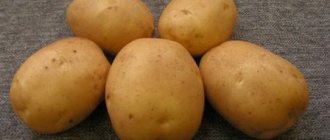There is no limit to varietal perfection: the history of Riviera potatoes
And again, breeders from the Netherlands, who never cease to amaze us, have created another miracle variety. Agrico has improved the valuable qualities of the popular potato crop. The Riviera variety is distinguished by consistently high yields, very early and rapid ripening of tubers, disease resistance, unpretentiousness and many other remarkable characteristics. Bred in 2007 in the vast Dutch fields, the Riviera variety is successfully cultivated in temperate climates. Distributed in Moldova, Ukraine, Belarus, and the Russian Federation. In the state register of Russia it is noted as a variety for cultivation in the central and southern regions, but it performs well in northern latitudes and zones of sharply continental climate (eastern regions of the country).
In areas of risky farming, it is recommended to grow Riviera potatoes using special agricultural technology to accelerate ripening: additional watering, fertilizer, loosening, germination before planting, selection of planting material, etc. In northern latitudes, the variety does not show maximum returns, but if the above rules are observed, it is capable give an early harvest of 270 to 320 centners per hectare. Tubers may vary in weight.
Reviews about the variety
According to reviews from gardeners, potatoes dug up in the early stages of ripening have the best taste. This variety is used to prepare purees, salads, soups, and also fry it. The tubers have an average digestibility.
Riviera potatoes are the favorite variety of most gardeners and farmers. The main difference from other varieties is fast ripening and excellent taste, as well as being unpretentious to soil quality and resistant to dry periods. Properly prepared material and preventive measures against pests guarantee an excellent potato harvest.
Early ripening potatoes of the Riviera variety, Chernigov:
Description of the Riviera variety and photo of tubers
In order not to be unfounded when talking about its popularity, let’s consider all the characteristic features of this hybrid, its pros and cons.
Productivity and ripening time
Riviera potatoes produce an abundant amount of root crops - up to 20 tubers per bush. The final product yield is up to 46.5 tons per hectare, 190–370 kg of potatoes per hundred square meters. Variation in indicators depends on climatic and weather conditions, seed material, care, and soil condition.
Potato variety Riviera: ripening period 35–40 days
Data were obtained experimentally according to which, one and a half months after planting, the yield is 140–220 kg per hundred square meters, and after 55 days – 270–310 kg. The optimal time for harvesting and full release of planting material is considered to be 80 days. Riviera potatoes gain marketable weight within 40 days after germination. Marketable 80–96%. The weight of one fruit is from 100 to 180 g. The yield of marketable products ranges from 85–95%, loss during winter storage is 4–5%. The Riviera variety is suitable for use as an early potato and for long-term storage.
To increase productivity, use drip irrigation. Water supplied not intensively, but in light small portions, will not harm the potatoes, but will make the soil loose, breathable, and nourished. Irrigation will create a foggy humidity condition in which the plants will receive sufficient water. Installing drip irrigation for a potato field will pay for itself in the first year of planting. With this approach, the yield indicator rises by one and a half times.
Appearance and taste - description and photo of the variety
The Riviera bush is tall (up to a meter), semi-erect, with large dark green leaves, wavy at the edges. During the growing season, red-violet flower corollas form on the plant. The root system is powerful, the stems are dense and strong.
Thanks to a well-developed root system, the plant can obtain moisture from a fairly large depth. This gives the advantage of growing in the southern regions of the country, where the soil suffers from drought. In addition, early ripeness allows you to get fruits before the driest season.
Potato tubers from one Riviera bush
The root vegetables are rough in appearance, light yellow in color, smooth oval or oval-round, medium in size, with small eyes and thick skin. Inside - white with a cream or light yellow tint.
The taste of this potato on a five-point scale is 4.8. Its starch content is 12–19.6%. When cooked, it crumbles, has a persistent aroma, and is great for making purees.
Tubers of the Riviera variety have a light yellow flesh color
Characteristics of the pros and cons of the variety
Like any potato variety, Riviera has its pros and cons, taking into account which you can choose the ideal conditions for its cultivation and understand how good it is for your site.
Advantages and disadvantages of the Riviera variety - table
| Advantages | Flaws |
| Early ripeness (from 35–40 days) | Stems and roots are not resistant to late blight when harvested late |
| High yield (up to 46.5 t/g) | The variety is unadapted to northern latitudes. Low yields in continental and sharply continental climates |
| Drought resistance | |
| Resistance to golden and cyst nematodes, potato cancer, viral and fungal infections (scab, bacterial rot), late blight in conditions of timely harvesting from fields | |
| Transportability | |
| Good performance during long-term storage | |
| High taste qualities | |
| High marketability indicators |
From the table we see that the variety has more significant advantages than disadvantages.
Riviera produces even, round potatoes with high taste qualities
Video: review of the Riviera variety
Description of the plant
The bushes of this variety grow to a height of more than 70cm. Stems are erect, ribbed. Sometimes they can bend a little, then the bush turns out to be spreading. There are many leaves on the plant. They are light green in color, potato-shaped and quite large. In the lower part of the plant the leaves are yellowish and smaller.
The flowers are collected in simple inflorescences. The corollas are fused at the base, the petals are reddish-violet. After pollination, few berries are set and they partially fall off. But usually the bushes do not have time to bloom, because... potatoes are harvested earlier.
About 10 oval-round tubers ripen in the fruit nest. The peel color is light yellow. It is slightly rough to the touch. The eyes are barely visible on the surface. The pulp is firm and also light, almost milky in color. The starch content is 19.6% and sugar 0.4%. These indicators determine the taste of potatoes and their aroma.
Planting tubers and caring for potatoes
The Riviera variety feels best in open sun and loves loose, nutritious soil. The ideal soil is light sandy loam, moderately moist, breathable. It is not a good idea to grow potatoes in the same place year after year, as the fertility of the land decreases without crop rotation. Alternate planting potatoes with other fruit plants or green manure.
On heavy clay soils, you risk getting a very small, ugly and tasteless harvest. Sandy, excessively peaty, overly moist soils, poor in calcium and magnesium, will certainly affect the yield, shape and size of the fruit.
In summer cottages, potatoes are often the first crop planted on newly dug virgin soil, and for good reason: after just one season of potato cultivation, the soil becomes loose, fertilized and is perfect for further planting of other vegetable plants.
Preparation of planting material and site
It is better to select seed material in the fall, when the potatoes are harvested. Immediately sift out small tubers and place them in a separate box or bag for storage.
Before planting, it is recommended to germinate seed potatoes until shoots of 0.5–2 cm appear. This will allow the potatoes to take root faster and sprout sprouts for green tops, as well as rhizomes for the formation of early tubers.
Sprouted potato tubers, ready for planting in the ground
At the end of winter, take out your seed potatoes and check them. Remove the sprouts that appear in the dark, sort out all the tubers. A month and a half before the planting season, spread the seed potatoes in one layer and place them in a bright place for germination. The optimal temperature is 10–15 degrees. Planting potatoes are heated in the sun for two to three weeks until they turn green.
From the sprouts that appeared over the winter while the potatoes were in the cellar or basement, you can grow seedlings. Agricultural technology is not complicated. The sprouts are broken off from the tuber and planted in a glass or other container. While the bush is growing, small nodules form in its roots, which next time will serve as seed material.
Potatoes should only be planted in warm soil. Planting the Riviera variety in April, provided that the ground has already warmed up sufficiently, will give a good harvest by the end of May. Different regions have different planting times. There's no point in rushing. Potatoes will still not germinate until the soil warms up to the planting depth (6–10 cm). Planting is carried out in moist soil. Riviera produces very strong and long rhizomes. It is believed that the best seed potatoes are tubers the size of a chicken egg, weighing 30–60 grams, preferably no more.
Time and scheme for planting potatoes
Most often, potatoes begin to be planted in early May, in the southern regions - in April. According to popular belief, the best time to plant potatoes is when the leaves on the birch tree bloom to the size of a five-ruble coin.
Tubers are planted at a distance of 35–40 cm between holes, 65–70 cm between rows. Use string to mark the rows.
Planting Potatoes - Step-by-Step Guide
- The soil needs to be dug up or plowed before planting. Dolomite flour or lime must be added to acidic soil. The earth should warm up to a temperature of 10–15 degrees.
- Mark the rows for planting potatoes using strings with a gap of 70 cm between them.
- You can add a handful or two of humus or manure into the created holes or furrows and add just a little wood ash.
Ash is an excellent fertilizer for many crops, including potatoes
- Place the potatoes, height up, in increments of 35–40 cm.
Potatoes are planted at a distance of 35 cm from each other to form rhizomes with tubers
- Cover with soil so that the tubers are at a depth of 6–10 cm.
How to properly germinate and plant potatoes - video
Potato agricultural technology
The Riviera variety does not need abundant watering, with the exception of particularly dry periods. In the eastern and northeastern zones of risky farming in Russia, it is imperative to monitor the weather. If it rains heavily, it would be a good idea to feed the soil with dry mineral fertilizers. If there is a drought, it is worth digging up potatoes in order to control and suppress the massive spread of late blight on tubers.
Industrial cultivation of Riviera potatoes
Potatoes love loamy, peaty and sandy loam soils rich in nitrogen and potassium. In villages and rural areas, fertilizing with humus and rotted manure directly into the holes is very common. On large fields, farmers use fertilizers in liquid form: a solution of chicken droppings or slurry.
A mandatory procedure in potato agricultural technology is loosening . In most cases, gardeners hill up potatoes so that the root stems do not become bare and do not get sick, and the tubers sprouting in the ground are better filled and saturated with oxygen. For the same purpose, it is necessary to promptly remove weeds from the area. Potato roots use much more oxygen when growing and filling than other crops.
Hilling of potatoes is carried out twice a season. The first - when the tops are 14–16 cm high, the second - two to three weeks later, before flowering. The tools used are a hoe or a flat cutter, but you can also do this using a cultivator, walk-behind tractor or other equipment.
Hilling up potatoes in classical cultivation is carried out twice a season.
Sprouted potato shoots will appear in 8–12 days. When planting unprepared seed material, you will have to wait two to three weeks longer for their appearance.
Planting potatoes in furrows and double hilling is a classic technique for growing potatoes. However, these days, natural farming methods are gaining popularity, when no digging, no loosening, much less plowing is carried out: the tubers are laid out on the surface of the ground and covered with a thick layer of straw.
The famous English agrarian F.L. Milthorpe in his book “Some Aspects of Plant Growth and Development (Growth and Development of Potatoes)” describes three phases in the formation of a potato bush:
- in the first - pre-emergence phase - roots and leaves are formed due to nutrients from the mother tuber; the speed of the phase is determined mainly by the soil temperature and the size of the sprouts at the time of planting;
- in the second phase there is active growth of tops due to soil nutrition of the roots;
- in the third phase, tuber growth occurs, partially coinciding with the growth of tops.
At each stage, one way or another, it is necessary to provide the potato plant with everything it needs. Proper application of fertilizers cannot be done if varietal characteristics are not taken into account.
To get a good harvest, you need to provide the potatoes with everything they need
Application of mineral fertilizers for potatoes - video
Fertilizers are applied to potato rows in liquid form (watering with grass infusion or diluted manure, spraying on the leaves) or in dry form - during the loosening process. To increase the effectiveness of fertilizers, use mulch.
Table: fertilizing potatoes
| Period | Mineral | Organic |
| At the beginning of germination, before hilling | Nitrogen fertilizers: ammonium nitrate and urea 10 g per 1 m2 |
|
| Phase: 4 leaves per plant | Foliar foliar feeding: Gumate+7, 2 g per 10 liters, 3 liters per hundred square meters | |
| At the end of flowering | Foliar feeding by leaf: 100 g of superphosphate per 10 liters of water, consumption: per 10 m2 |
Preparing the site for planting
In order for the variety to meet all expectations, you need to choose the most suitable site for planting. It is best if it is a lighted place with light soil. An area protected from the winds and well warmed by the sun is well suited. Snow and melt water do not accumulate in such places. Therefore, for early Riviera potatoes, just such a plot is left. Before planting, the soil is dug up and organic matter is added.
Important! The use of fresh manure or bird droppings is strictly prohibited. Only good quality humus is suitable for fertilizer.
Riviera potatoes respond well to the addition of ash and nitrogen. The area must be cleared of weeds. Riviera potatoes should be planted when the soil warms up to +10 degrees, not earlier. The planting pattern for the early variety is 60x35 cm. Riviera potatoes are planted by deepening the tubers by 6 cm. This figure is less than that of other early varieties.
Diseases and pests of varieties and methods of combating them
The misconception of many gardeners is the misconception that various spots, rot and ulcers are the result of the influence of weather conditions. In fact, potatoes have a lot of diseases and pests throughout the entire period of growth and development. Let us consider exactly those diseases and pests that are potentially dangerous for the Riviera variety.
The advantage of early varieties is that they suffer much less often from damage, since they manage to harvest before the massive spread of diseases or pests.
Late blight of potatoes
A fungal disease that affects both stems and tubers. According to statistics, gardeners lose more than 10% of their harvest due to late blight. If you harvest untimely, you can lose up to 50%. It develops extremely quickly.
Signs of late blight: characteristic black spots appear on stems and leaves
Phytophthora mycelium is found in infected potato seeds or in soil with plant residues. The situation is aggravated by dense plantings - then infection occurs en masse and twice as fast. The incubation period of mushrooms is 4–16 days. The best development conditions are a humidity of 90% and an ambient temperature of 15 degrees.
External signs of potato tuber late blight
The main signs of late blight: dark and brown spots on the leaves and stem. On the back of the leaf you can see white fungal spores. They are easily transported by water and wind, making them difficult to combat.
If you notice the onset of late blight damage in time, the crop can still be saved with the use of chemicals. Late blight is dangerous because it develops very quickly and within a few days the leaves curl and dry out. The tubers become hard, covered with dark spots and become a source of disease for neighboring healthy root crops.
Methods to combat late blight
- Choosing a place to plant potatoes: the area should be flat and not in a low-lying area to eliminate the risk of moisture stagnation, which is a good condition for the development of the disease.
- Careful soil preparation. It should not be heavy or clayey.
- The area should be well lit by the sun and ventilated.
- Crop rotation. You cannot plant potatoes in one place for several years in a row; you should alternate plantings. This also applies to other cultures.
- Careful selection of seed potatoes. Do not spare damaged, dark, suspicious tubers. After the potatoes for planting have warmed up for 7–14 days, the first signs of late blight damage can already be seen. This is how infected planting material is determined.
- Treatment with fungicides that increase potato resistance to disease.
Table: fungicide treatment
| Shirlan |
|
| Immunocytophate |
|
One of the preventive methods of protection against late blight is the application of mineral fertilizers, primarily potassium and phosphorus.
Colorado beetle
Potatoes are damaged by the leaf beetle, which feeds on the leaves of nightshade crops, as well as its larva. The beetle is very prolific, voracious and can adapt to any unfavorable factors. It appears en masse during the budding and flowering phase of the plant. If 70–80% of the tops are destroyed by beetles, the potato yield will be 50% lower.
Adult Colorado potato beetle
Fighting methods
The Colorado potato beetle does not tolerate pollination by wood ash. Even an adult dies after such treatment.
Spraying with insecticides requires alternating medications, as the beetle gets used to them. Help in the fight:
- Sumi-alpha - 15 g (ml) per hundred square meters;
- Actellik - 15 g (ml) per hundred square meters;
- Arrivo - 10–16 g (ml) per hundred square meters;
- Bulldog - 15 g (ml) per hundred square meters.
How to deal with the Colorado potato beetle without chemicals - video
Wireworm
This is the larva of a click beetle, mistaken by many for a worm. A dangerous pest of potatoes, it spoils a very large percentage of the crop, multiplying quickly.
The main signs of wireworm damage are: gnawed holes in potato tubers, eaten away by the larva. Such tubers do not have a marketable appearance and cannot be stored as they quickly rot.
The saddest thing is that the click beetle is widespread everywhere. In April, it lays larvae in the ground and thus breeds a whole horde of voracious pests of garden root crops.
Wireworm - larva of click beetle
Fighting methods
By all possible means: from mechanical to chemical.
- Remove larvae manually when digging the ground.
- They set bait by burying jars with a piece of potato tuber. Every 2-3 days the trap is inspected and the wireworms caught in it are destroyed. One trap per 1 m2 is enough, but if you have a wireworm epidemic, put more.
- The wireworm does not like green manure: phacelia, mustard. These plants cleanse the soil and improve its composition.
- Throughout the season, scatter crushed eggshells, saltpeter, charcoal, ash, and chalk over the area.
- A handful of onion peels or pine needles placed in the hole before planting potatoes can repel the wireworm.
- Before planting, do not be lazy to water the holes or furrows with a weak solution of potassium permanganate.
- And the most effective remedy: fertile soil. The more organic matter the soil on a site contains, the less often wireworms are found there.
Features of cultivation
Like any crop, this potato has a number of requirements that must be observed when growing.
Germination
To obtain early and vigorous shoots, Riviera seed potatoes need to be germinated before planting in the ground. To make the eyes hatch faster, the tubers are placed in small boxes, which are placed in a room with a constant air temperature of at least +15 degrees. They are kept in this state for 3-4 weeks. During this period, the potatoes can be turned over several times so that the sprouts form evenly.
You can also germinate planting material in transparent plastic bags, if you make holes in them for ventilation and hang them in a sunny place. The greenhouse effect will allow you to get good sprouts in just 2 weeks.
Landing
The area for Riviera potatoes should be flat, well-lit, with deep groundwater. When planted in damp, shaded areas, the tubers will be affected by various fungal diseases, as a result of which the yield will noticeably decrease.
It is advisable to prepare the soil in the fall, namely, dig up and sow mustard, thanks to which the space allocated for potatoes will not be attacked by weeds. In the spring, the area is dug up again, and the mustard greens will serve as organic fertilizer.
The seed should be planted in the ground no earlier than May. By this time, the earth, as a rule, warms up to +12 degrees. Planting material is laid out in prepared holes with a distance of 30 cm between bushes and 80 cm between rows. Before planting, it is recommended to spray seed potatoes with a solution of potassium permanganate and sprinkle with ash. This is an excellent prevention of many diseases.
You should not hide the sprouted tubers too deeply in the soil; a depth of 5-6 cm is enough. This way, the new crop can be harvested even earlier.
If planting is done before the arrival of May (in poorly warmed soil), then the area must be mulched. For these purposes, a special covering material or any plant alternative is used: hay, sawdust, fresh mown grass, dry leaves, etc. Mulching allows you to retain moisture and heat, and also prevents the massive appearance of weeds.
Care
Riviera potatoes have received reviews from all over our country due to their unpretentiousness. After planting, you only need to weed it a few times, hill it up and water it, and after 1.5 months you can enjoy the results of your labor.
Pest and disease control. If weather conditions are unfavorable or the tubers are not dug up in a timely manner, Riviera can be damaged by late blight, scab and macrosporiosis. Therefore, every gardener should always have protective equipment against these diseases in his arsenal. Copper sulfate, copper oxychloride, Bordeaux mixture, Maxim, Metaxil and other store-bought preparations cope well with the problem.
Harvesting and storage
Full harvesting of Riviera potatoes must be carried out no later than 2.5 months from the date of planting. By this time, the stems will have dropped to the ground, the peel will have hardened, and the tubers will have stopped growing. There is no point in keeping them in the ground any longer. Potatoes are harvested manually with a shovel or pitchfork.
After digging, the tubers are dried in the sun for several hours, turning them over periodically. The next stage is sorting. First, seed potatoes are selected for planting next year, then spoiled specimens are removed from the total mass. If they are sick then they should be discarded. Potatoes damaged mechanically are immediately used for cooking. High-quality tubers are stored in special boxes or piled in a cellar.
Harvesting and storing potato harvest
Potatoes are traditionally harvested in late summer - early autumn. If you plan to harvest the crop for winter storage, it is believed that after the tops dry out, the potatoes should lie in the ground for another month: during this time, the peel will become denser, which will allow the tubers to retain their properties longer.
Terms and rules of cleaning
Early varieties such as Riviera can be harvested as early as late June - early July. To make sure that you can already harvest the crop, first pull out one bush and dig a hole.
It is important to dig up the bush correctly so as not to cut the tubers
An old method for determining the maturity of potatoes: if the soil around the tops is cracked, it means that the tubers are already full and can be dug up.
In fact, the timing of potato harvesting depends on the climate. In the south, potatoes are dug only in November, but in northern latitudes - already in the third ten days of September. In any case, you need to have time to dig up the potatoes before the ground freezes.
However, Riviera is an early variety and is harvested in the summer. Autumn harvesting, as a rule, is relevant for those who grow potatoes in 2 harvests.
When harvesting potatoes, carefully dig up the row with the tops with a pitchfork, slightly to the side of the hole. This must be done carefully so as not to pierce the tubers with the pitchfork. If damaged, they will not be stored. The tops themselves need to be torn out, and potatoes collected from the rhizomes. Don’t forget to dig them out of the ground itself; sometimes the largest ones remain there.
Bookmark for storage
Before putting the potatoes in the cellar, you need to sort them and take a number of measures:
- Remove all bad tubers, damaged, painful. These are not only not stored, but can also be infectious to healthy potatoes.
- Sorting is needed to separate seed potatoes from food potatoes. It is best to perform this operation now, so that it will be easier in the spring. In addition, the seedlings need to be greened, that is, placed in a sunny place for a while so that the tubers turn slightly green - this will improve their germination.
- For best long-term storage, tubers should be pickled with copper sulfate . Dilute 2 g in 10 liters of water and gently spray the crop.
- Potatoes should be stored in the cellar. Potatoes retain their quality well in a cool (2–40C), dark, dry, well-ventilated place. At low temperatures, the tubers lose their taste; at higher temperatures, growths quickly appear.
- It is better to whitewash the cellar where you plan to store the harvest with lime. This will disinfect the room. It is recommended to line the bottom of the cellar with dry matting.
Do-it-yourself mini-cellar for potatoes - video
Farmers' opinions
Reviews from experienced gardeners were selected from thematic forums, briefly characterizing Riviera potatoes.
- Lera from the Kaluga region writes: “I have been growing this variety for several years in a row. Mainly to eat new potatoes. I send some for storage. Riviera has good keeping quality and does not fade.”
- Elena from Kursk shares: “Last year we planted 100 kg and collected about a ton. Moreover, we did not water it on purpose. The only thing they did was fill the rows with hay.”
- Galina from the Tula region.
For greater clarity, we recommend watching a video review from a summer resident about the Riviera potato harvest.









